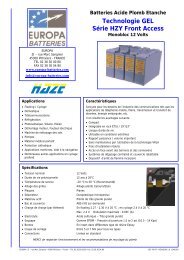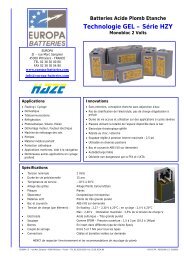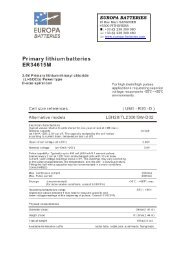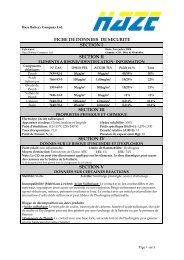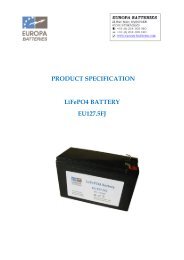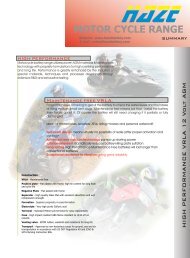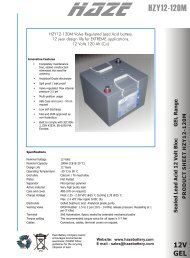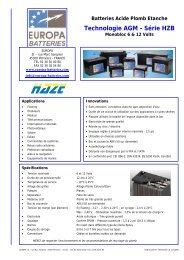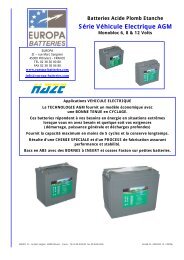PRODUCT SPECIFICATION LiFePO4 BATTERY ... - Europa Batteries
PRODUCT SPECIFICATION LiFePO4 BATTERY ... - Europa Batteries
PRODUCT SPECIFICATION LiFePO4 BATTERY ... - Europa Batteries
You also want an ePaper? Increase the reach of your titles
YUMPU automatically turns print PDFs into web optimized ePapers that Google loves.
<strong>PRODUCT</strong> <strong>SPECIFICATION</strong><br />
<strong>LiFePO4</strong> <strong>BATTERY</strong><br />
EU1217FJ
1. SCOPE<br />
The product specification describes the requirement of the <strong>LiFePO4</strong> Cell to be supplied to the<br />
customer by EUROPA <strong>Batteries</strong>. Should there be any additional information required by the customer,<br />
customer are advised to contact EUROPA <strong>Batteries</strong>.<br />
2. DESCRIPTION Rechargeable <strong>LiFePO4</strong> Battery<br />
3. Model EU1217FJ<br />
4. GENERAL <strong>SPECIFICATION</strong>S<br />
4.1. Nominal Capacity 17Ah/min 16.5Ah (at 0.2C Discharge)<br />
4.2. Charging Voltage 14.6V±0.05V<br />
4.3. Average working Voltage 12.80V,@0.2C<br />
4.4. Standard Charge Method Constant Current and Constant Voltage (CC/CV)<br />
Current 0.2C<br />
Voltage 14.6V<br />
End Current 800mA<br />
End time 4h<br />
4.5. Maximum Charge Current 1C<br />
End time 2.5h<br />
4.6. Standard Discharge Constant Current (CC)<br />
Current 1C<br />
End Voltage 8.0V<br />
4.7. Maximum Discharge Current 1C, 3C peak<br />
4.8. Cycle Life Capacity≥80% Nominal Capacity after 1000 cycles<br />
4.9. Weight of Bare Cell Approx. 1.8Kg<br />
4.10. Operating Temperature Charge 0°C ~ 45 °C<br />
Discharge -20°C ~ 60°C<br />
4.11. Storage Temperature 1 month -20°C ~ 45 °C<br />
6 months -20°C ~ 35 °C<br />
5. OUTLINE DIMENSION (UNIT: mm)<br />
5.1. Dimension: max167mm (T) ×max77 mm (W) ×max181mm (L), refer to the attached drawing 1.<br />
6. APPEARANCE<br />
There shall be no such defect as deep scratch, flaw, crack, rust, leakage, which may adversely affect<br />
commercial value of the cell.
7. TEST CONDITION AND DEFINITIONS<br />
7.1. Measuring Equipment<br />
1. Voltmeter<br />
Inner impedance>1000Ω per volt.<br />
2. Ampere-meter<br />
Total external resistance(ammeter and wire)
8.6. Cycle Life<br />
Charge cells per 4.4 Rest 10 minutes. Discharge per 4.6. Rest 10 minutes before recharge. A cycle is<br />
defined as one charge and one discharge. Discharge capacity shall be measured after 1000 cycles.<br />
Discharge capacity (1000th Cycle) ≥80% of Nominal Capacity<br />
8.7. Storage Characteristics<br />
After charge as per 4.4, store the testing cells at 20ºC±5ºC for 28 days. Then discharge at 0.2C to<br />
2.0V.<br />
Discharge capacity≥85% of Nominal Capacity<br />
8.8. Temperature Characteristics<br />
Cells shall be charged per 4.4 and discharged per 4.6. except to be discharged at temperatures per<br />
Table 1. Cells , full charged, shall be stored for 3 hours at the test temperature prior to discharging<br />
and then shall be discharged at the test temperature. The capacity of a cell at each temperature shall<br />
be compared to the capacity achieved at 20 ºC and the percentage shall be calculated. Each cell shall<br />
meet or exceed the requirements of Table 1.<br />
Table 1<br />
-10°C @0.5C 20°C@0.2C 60°C@ 1C<br />
≥40% Nominal Capacity 17Ah ≥90% Nominal Capacity<br />
8.9 Battery drawing:<br />
See attached file according to customers different request.<br />
Drawing 1
9. SAFETY<br />
9.1. External Short-circuiting Test<br />
Cell, charged per 4.4, is to be short circuited by connecting the positive and negative terminals of the<br />
cell with copper wire having a maximum resistance≤50 mohms. Stop the test when the battery<br />
temperature decays to about 10 ºC from the maximum.<br />
Criteria: No Explosion, No Fire<br />
9.2. Overcharge Test<br />
Overcharge test take constant current and constant Voltage. Charging at 3A firstly, the voltage<br />
increase following charging time. When voltage reach 40V, cell charge with constant voltage, the<br />
current decreases gradually. Stop the test when battery temperature decays to about 10ºC from the<br />
maximum or the current decays to less than 350mA.<br />
Criteria: No Explosion, No Fire<br />
9.3. Tack Through<br />
Hitting the battery with a nail of diameter 2.5~5.0mm for 6h,end test<br />
Criteria: No Fire, No Explosion<br />
9.4. Heating Test<br />
Cell, Charged per 4.4, is to be heated in a gravity convection or circulating air oven. The<br />
temperature of the oven is to be raised at a rate of (5±2)°C/min to a temperature of (130±2) °C and<br />
remain for 60 minutes at that temperature before the test is discontinued.<br />
Criteria: No Explosion, No Fire<br />
9.5. Pressing test<br />
Fix the testing cells in the middle of bottom armor plate, pressing the cells with 13kN.<br />
Criteria: No Explosion, No Fire<br />
10.Danger and Warning and Cautions in handing the battery<br />
Danger Warning<br />
Danger warning(it should be described in manual or instruction for users, indicated especially)To<br />
prevent the possibility of the battery from leaking, heating, explosion,<br />
Please observe the following precautions:<br />
1. Do not disassemble or reconstruct battery.<br />
2. Do not short-circuit battery<br />
3. Do not use or leave battery nearby fire, stove or heated place(more than 80 ℃)<br />
4. Do not immerse the battery in water or sea water , or get it wet<br />
5. Do not charge battery nearby the fire or under the blazing sun<br />
6. Do use the specified charger and observe charging requirement<br />
7. Do not drive a nail into the battery. Strike it by hammer, or tread it<br />
8. Do not give battery impact or fling it<br />
9. Do not use the battery with conspicuous damage or deformation<br />
10. Do not make the direct soldering on battery<br />
11. Do not reverse charge or overdischarge the cell<br />
12. Do not reverse-charge or reverse-connect
13. Do not connect battery to the plug socket or car-cigarette-plug<br />
14. Do not use battery for unspecified equipment<br />
15. Do not touch a leaked battery directly<br />
Warning<br />
1. Do not use Lithium ion battery in mixture<br />
2. Keep the battery away from babies<br />
3. Do not get into a microwave or a high pressure container<br />
4. Do not use a leaked battery nearby fire<br />
5. Do not use an abnormal battery<br />
Caution<br />
1. Do not use or leave the battery under the blazing sun(or heated car by sunshine). The battery may<br />
smoke, heat or flame. And also, it might cause the deterioration of battery’s characteristics or cycle life.<br />
2. Do not use nearby the place where generates static electricity (more than 64V).<br />
3. Do not charge the battery out of recommended temperature range of 0°C and 60°C.<br />
4. When the battery has rust, bad smell or something abnormal at first-time-using, do not use the<br />
equipment and go to bring the battery to the shop which it was bought.<br />
5. In case children use the battery, their parents teach how to use batteries according to the manual<br />
with care.<br />
6. If the skin or cloth is smeared with liquid from the battery, wash with fresh water.



